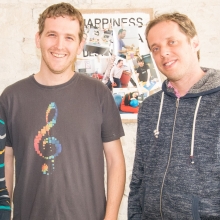One chemical building block at a time
Dr. Samer Gnaim is making the most of organic chemistry
New scientists

Born in the northern Israeli city of Baqa alGharbiyye in 1991, Dr. Samer Gnaim grew up captivated by the chemicals and the processes he witnessed at the lab where his father, a chemist, worked. “Since I was young, I always had a special feeling when visiting my dad’s laboratory, and I was consistently amazed by the fancy equipment, the chemical’s exotic colors, and even the smell of the lab. Although I understood nothing about chemistry yet, this experience definitely ignited my curiosity toward science and made me realize at a young age that I wanted to become a scientist,” Dr. Gnaim says. “Later on, during college and after a deep dive into chemistry, I was fascinated by the ability of organic chemists to build molecules in a precise fashion with a specific molecular function, such as drugs, molecular machines, and polymers.”
He decided to pursue his BSc in chemistry and biology at Tel Aviv University, where he continued on a direct-toPhD track, completing his degree in organic chemistry in 2019 under the supervision of Prof. Doron Shabat in the Department of Organic Chemistry. Dr. Gnaim’s research focused on the development of targeted drug delivery systems and chemiluminescence probes— light-emitting organic molecules—for diagnostic and therapeutic applications. He then carried out postdoctoral work in the lab of Prof. Phil Baran in the Department of Chemistry at the Scripps Research Institute in La Jolla, California.
Throughout his scientific career, Dr. Gnaim has had the opportunity to work on a broad spectrum of synthetic, organic-metallic, polymeric, and bioorganic chemistry challenges. On this journey, he studied the design of a chemiluminescent self-immolative molecular unit, which combines a dual function: chemiluminescence polymers light up when they encounter a specific target, and a smart polymer built into the complex is designed to sequentially disassemble the biochemical probe into its building blocks upon encountering a triggering event. This creates a very sensitive biosensor with a high signalto-noise ratio.
Pursuing other scientific studies, he has also experimented with biomolecular agents that selectively activate targeted drugs in the presence of a desired enzyme, and then release the active drug— now tagged by a green light—to monitor its location and progress.
A new tool for anti-cancer drugs Dr. Gnaim has also helped develop a new tool to overcome the drug delivery limitations of untaggable bioactive molecules. This technology is based on a new reagent that adds a functional ketone group that can act as a handle for a bioactive drug without interfering with its bioactivity. His team successfully tested their approach on three different anti-cancer drugs. Their reagent has been commercialized since 2017 and in 2018, the technology was adopted by American pharmaceutical giant Merck with the aim of integrating it into their drug discovery program.
Dr. Gnaim won several postdoctoral fellowships to pursue his studies at Scripps Research. There, he tackled the challenge of developing scalable synthetic electrochemical methods for sustainable insertion and subtraction of molecular hydrogen from organic molecules. This is a fundamental task in many chemical reactions and is often employed to unlock adjacent reactivity. Dr. Gnaim has created a new oxidative electrochemical process for carbonyl functionalities, which introduces a direct pathway for creating useful chemical building blocks by simply using electricity and a reagent that does not require expensive transition metals or exact quantities of materials for the reactions to succeed.
He and his co-workers have also explored electrocatalytic reactions using cobalt catalysts. This allowed the team to demonstrate a reductive electrochemical cobalt-hydride generation method for the hydro-functionalization of unsaturated carbonto-carbon bonds—a necessary step for a wide range of synthetic organic chemistry applications. Their method uses a simple proton source and electricity as the hydride surrogate, creating a versatile range of tunable reactivities with alkenes and alkynes that can be realized with unmatched efficiency and chemical selectivity. This significantly simplifies the synthesis of a wide range of products, from pharmaceuticals to reagents used in a variety of industrial processes. Investigating the unknown Dr. Gnaim is slated to join the Department of Molecular Chemistry and Material Sciences in November 2022. “My lab is mainly interested in pursuing fundamental research, and the Weizmann Institute is one of the world’s leading basic research institutions with great resources to support fundamental science,” he says. “This will give us the freedom to study areas that are under-explored in organic chemistry and synthesis.” The Gnaim lab will focus on developing new synthetic methods driven by electrochemistry, metal catalysis, and reagent development. This research program strives to expand the synthetic chemistry analysis toolbox, creating a more efficient synthesis of pharmaceuticals, natural products, and agrochemicals; a better understanding of late-stage functionalization of bioactive molecules and therapeutic agents; and exploring applications in materials, polymers, and bioorganic fields.
Education and select awards:
• BSc, cum laude (2013) and direct-track PhD (2019), Tel Aviv University (2013)
• Postdoc, Scripps Research Institute, California (2019-2022)
• The Israel Chemical Society’s Jortner Society Prize for Excellent Graduate Student (2017); Fulbright Postdoctoral Fellowship (2019); Rothschild Fellowship (2019-2020); Israel Council for Higher Education Scholarship for Outstanding Postdoctoral Student (2019-2020); Sir Charles Clore Prize for Outstanding Researcher Appointed as Senior Scientist (2022)







